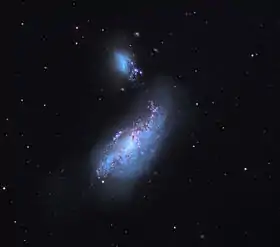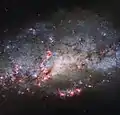NGC 4490
NGC 4490, also known as the Cocoon Galaxy, is a barred spiral galaxy in the constellation Canes Venatici. It lies at a distance of 25 million light years from Earth. It interacts with its smaller companion NGC 4485 and as a result is a starburst galaxy. NGC 4490 and NGC 4485 are collectively known in the Atlas of Peculiar Galaxies as Arp 269. NGC 4490 is located 3/4° northwest of beta Canum Venaticorum and with apparent visual magnitude 9.8, can be observed with 15x100 binoculars.[2] It is a member of Herschel 400 Catalogue. It belongs in Canes Venatici galaxy cloud II.
| NGC 4490 | |
|---|---|
 | |
| Observation data (J2000 epoch) | |
| Constellation | Canes Venatici |
| Right ascension | 12h 30m 36.2s[1] |
| Declination | 41° 38′ 38″[1] |
| Redshift | 565 ± 3 km/s[1] |
| Distance | 25.1 ± 5.0 Mly (7.7 ± 1.5 Mpc)[1] |
| Apparent magnitude (V) | 9.8 |
| Characteristics | |
| Type | SB(s)d pec [1] |
| Apparent size (V) | 6′.3 × 3′.1[1] |
| Other designations | |
| Arp 269, UGC 7651, PGC 41333[1] | |
It was discovered by William Herschel in 1788. Two supernovae have been observed in NGC 4490, SN 1982F, and type II-P SN 2008ax, with peak magnitude 13.0.[3][4]
Gallery
 Extreme tidal forces have carved out the shapes and properties of NGC 4490.[5]
Extreme tidal forces have carved out the shapes and properties of NGC 4490.[5]
References
- "NASA/IPAC Extragalactic Database". Results for NGC 4490. Retrieved 2016-01-18.
- Craig Crossen, Gerald Rhemann (2012). Sky Vistas: Astronomy for Binoculars and Richest-Field Telescopes. Springer Science+Business Media. p. 233. ISBN 978-3-7091-0626-6.
- List of Supernovae IAU Central Bureau for Astronomical Telegrams. Retrieved 29 December 2015.
- David Bishop. "Supernova 2008ax in NGC 4490". supernovae.net (International Supernovae Network). Archived from the original on 8 April 2010. Retrieved 7 June 2010.
- "Bursting with Starbirth". www.spacetelescope.org. Retrieved 28 September 2017.
External links
| Wikimedia Commons has media related to NGC 4490. |
- NGC 4490 on WikiSky: DSS2, SDSS, GALEX, IRAS, Hydrogen α, X-Ray, Astrophoto, Sky Map, Articles and images
- SEDS
This article is issued from Wikipedia. The text is licensed under Creative Commons - Attribution - Sharealike. Additional terms may apply for the media files.